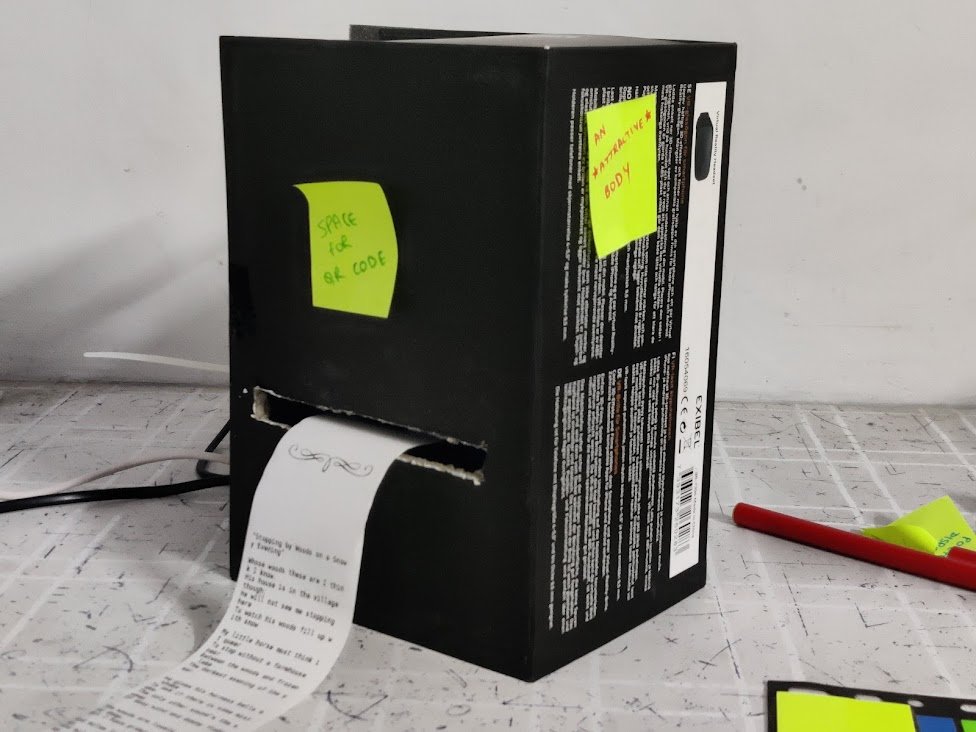How might we bring small writers to a wider public?
Independent Project
Physical computing
Prototyping
Venture building
2022
The Poetry Dispenser
Inspired by old Indian Railway station weight machines, the dispenser churns out a random poem / short story from a pool when you make a small payment. Part of the payment directly goes to an independent writer.
Commercial ‘partners’ (cafes, bookstores, salons, toy stores etc.) can host these dispensers in revenue-sharing agreements and increase their footfall, waiting-line engagement, advertisement avenues and customer recall value.
This can enable a huge micro-publishing industry with a low barrier of entry for independent writers, ease discovery of new writers among readers, and encourage localised stories.
CONCEPT NOTE
I was travelling back from a rough day at work. I wanted to engage myself but didn’t want to look at a digital screen again.
I wondered if a small piece of poetry could lift me up and surprise me, and perhaps act as a souvenir to mark that day and journey.
ORIGIN STORY
INSPIRATIONS
[A disposable piece of paper to take with you, enriched with value]
There used to be these weighing machines at Indian Railway Stations (now discontinued) that would often print you out your fortune / “which movie star are you?” / body-weight on a piece of paper.
As a kid, the experience was largely about the ‘wonder’ of a machine churning out something surprising.
I wanted to capture that.
STORY(BOARDING) TIME
I tried drawing what I felt that day into a rough story scenario.
IDEATION
BRAINSTORMING ‘VALUE’
What might this piece of paper
mean for someone?
Who is this someone?
And why are they interested?
CHARACTER SKETCHES
ACCESS / TOUCHPOINTS
How will it reach them?
*I called 3 of my friends to kickstart.
Then I interviewed 10 people at the nearest bookstore and a popular cafe.
MAPPING THE ECOSYSTEM
How will value and money change hands?
What does everybody win?
* ₹ = Indian Rupee symbol
The diagram uses a cafe setting, but I found the dispenser most appropriate as stand-alone machines in bookstores, waiting lobbies, art exhibits and stationery stores
A VALUE HYPOTHESIS
What things does The Story Dispenser need to just come to life (and sustain)?
I decided on key offerings that I’d want to observe and test when I set it up in public
I also did a check to see if these decided offerings are true to the overall feelings that I initially wanted to capture through the machine
-
It needs to be cheap, yet be sufficient to compensate a writer when operating at scale.
Needs to enable enough margin to fund printing costs. I set my hypothetical amount at Rs 30 INR
(~40 cents USD) per piece. -
It rests on good curation and surprise. The pipeline could have a store of poems, based on accepted submissions made online by writers for each piece of work.
Each piece can be given a ‘shelf-life’ to keep the pipeline fresh.
No options for a genre to the user.
An attention-drawing exo-skeleton for the dispenser.
-
Writers need not publish exclusively through this - because the primary “draw-in” of the customer isn’t based on a particular writer or expectation, but content discovery and surprise.
Can be used as an avenue for writers to publicise their work and draw more readers to their social media handles.
Submissions through a simple online form.
THE PITCH FOR ‘PARTNERS’
PARTNERS COULD USE THE POETRY DISPENSER TO:
For its uniqueness, make the commercial spaces memorable and generate a high recall value in customers. Can be coupled with additional branding of print papers with store logos.
Stand-out with add ons
… and anchor attention. Since the story print is a unique but cheap and fast-moving good, use it as a “draw-in” to the store for crowds and to draw byproduct attention to primary revenue generators of the store (eg: books in a bookstore)
Increase store footfall
Keep customers engaged and self-entertained across waiting lines, corporate lobbies and ease them before even your first touchpoint of service. Specially helpful in tense spaces (doctor’s lobby, interview waiting, etc)
Un-bore waiting-lines
I borrowed a receipt printer, coded my Raspberry Pi to pull a random poem from a folder on it, and send custom print instructions on trigger.
PROTOTYPING
Reflections
I’ve often wondered:
if design is about solving (towards and for) well-defined problems - often under very specific key performance indicators - what role does creativity even play in the process?
Except through this project I realised that design is also about conjuring futures from present contexts and stories-at-play.
The process of sense-making (of research, hypotheses and tests) across any design process is in itself a creative act.




























